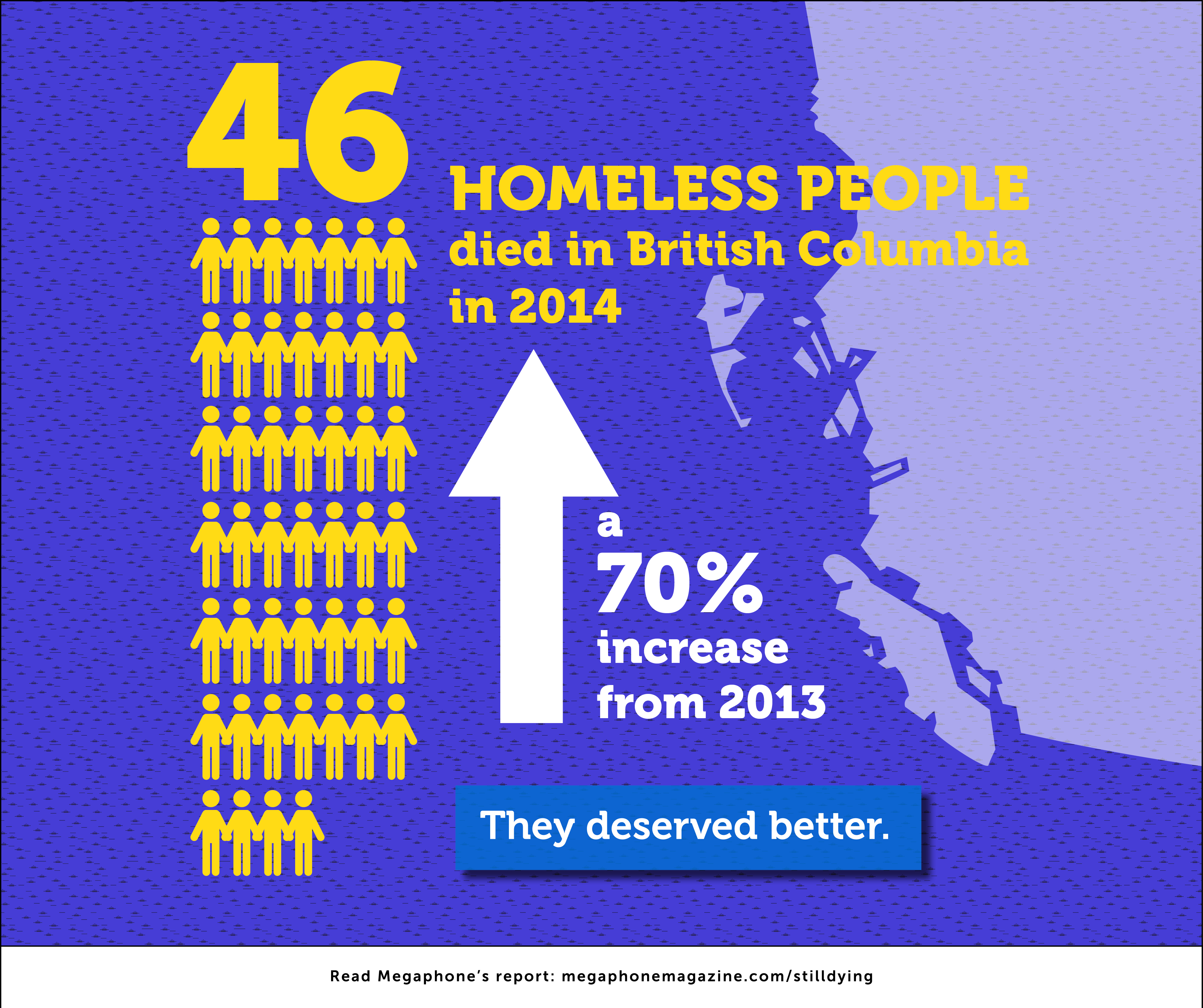This week’s infographic, published by Megaphone, takes a look at homeless deaths in British Columbia. Megaphone is a monthly magazine published by the not-for-profit Street Corner Media Foundation. Printed copies of the magazine are sold by the non-profit to vendors for 75 cents, and sold by the vendor for two dollars, which adds up to a $1.25 profit per sold magazine copy. The primary vendors for the magazine are individuals with low-income and those experiencing homelessness. To learn more about this innovative program that aims to provide economic opportunity for people experiencing poverty while simultaneously building grassroots support in the fight against poverty, I invite you to watch their vendor recruitment video.
The infographic below states that at least 46 homeless people died in British Columbia in 2014. This was a 70% increase from the previous year’s figures. This figure is drawn from a Megaphone report, Still Dying on the Streets, which investigated reportable deaths of homeless individuals. Taking a closer look at the key findings of the report establishes the disparities that exist between the homeless population in British Columbia when compared to the general population. The average age of death for the general population is 76.4 years, the median age of death for a homeless person in British Columbia was just 40-49 years of age. Compared to just 16.5% of deaths in the general population, 48.3% of all reported homeless deaths are reported by the coroner’s service as being ‘accidental’. This term includes deaths that were caused by alcohol and drug use, including illicit drug overdose. Another important finding from the report is that between 2006 and 2013 Aboriginal Peoples accounted for 15.6% of all homeless death, while only making up 5.4% of the population in the province.
The homeless death count cited in Still Dying on the Streets comes from a report published by BC Coroners Service earlier this year. It is important to recognize that provincial coroner services do not investigate all deaths that occur. Accordingly, the coroner services estimate the number of homeless deaths that occurred in BC in 2014 is roughly twice as high. It is also important to remember that this figure likely does not include the deaths of individuals who were living in hidden homelessness. The term hidden homelessness refers to the housing situation of “people who are staying with relatives, friends, neighbours or strangers because they have no other option.” While these figures may not be the most precise or accurate, they do provide an important starting point for discussions on the issue.
A look at Ontario
A recent investigation by the Toronto Star found that “most municipalities across Ontario do not track homeless deaths fully — or at all”. In 2007, the City of Toronto began collecting data on deaths of shelter residents but many are left untracked if they occur outside the shelter system. The Toronto Homeless Memorial, maintained by the Church of the Holy Trinity with the help from volunteers and charities, has also been tracking those who died while experiencing homelessness in the GTA and holds a monthly memorial service. We wrote more on memorials across the country and in the US in our previous Ask the Hub. More recently, City Council voted to track homeless deaths both inside and outside shelters in Toronto. However, the province does not currently have a governing body that keeps track of homeless deaths and there are no mandatory requirements for municipalities. This lack of data ultimately translates into a lack of understanding about mortality among homeless populations.
Evidently, improvements in data collection are much needed across Canada in order to (1) obtain a thorough understanding of the crisis and (2) respond with evidence-informed programming and solutions.


